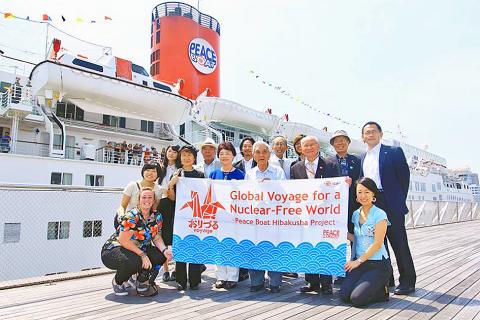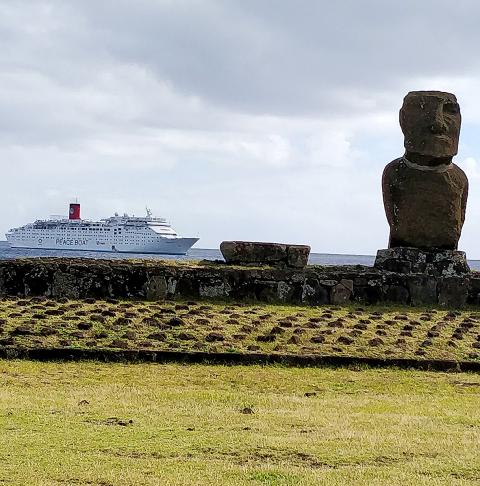After arriving in Hsinchu at the age of 16, Lee Yong-soo was repeatedly raped. She had been catching snails in what is today South Korea’s Daegu when she was kidnapped by a Japanese soldier and sent to Taiwan to serve as a sex slave for the Japanese military. She wouldn’t return home until the end of World War II.
Lee is among hundreds of thousands of women from throughout Asia, euphemistically know as “comfort women,” who were abducted from their homes to service Japanese soldiers in occupied territories before and during the war. Since 1998, she has traveled throughout the world discussing her experiences as a sex slave, a story that forms part of a lecture by Akira Kawasaki about using past atrocities to discuss peace education.
Kawasaki, a member of the Executive Committee of Peace Boat, a Japan-based international NGO working to promote peace, human rights and sustainability, will give the talk on Sunday as part of the Lung Yingtai Cultural Foundation’s Taipei Salon. The talk, in English, will be moderated by Shaw Mai-yi (邵梅儀), an academic at the Hong Kong University of Science and Technology.

Photos courtesy of ICAN
“Peace Boat has promoted dialogue among Japanese, Korean and other Asian participants in pursuit of building a common history ... and a shared commitment to not repeat [past] mistakes, while promoting rights, dignity of and healing for those affected,” Kawasaki tells the Taipei Times.
It’s a project that is perhaps needed as much today as ever before. With authoritarianism on the rise throughout the globe and as Japanese Prime Minister Shinzo Abe continues a campaign of denial about Japan’s atrocities during World War II, Kawasaki’s goal to educate the younger generation will only grow in importance.
SEX SLAVES

Photo courtesy of Wikimedia Commons
Kawaskai says that because the Japanese education system largely avoids this part of its World War II history, “many Japanese participants are shocked to listen to the brutal memories,” as told by Lee he said.
Japan’s current political climate, Kawasaki adds, plays a role in this.
“[T]he current Japanese political leaders, including the prime minister himself and those supporting him, have been promoting an ideological campaign to deny the past which has had certain impact on the public opinions of the Japanese people,” Kawasaki said.
Which is why, he added, that Peace Boat is critically important because the kinds of grass-roots education that it uses will “bear fruit in the long term to restore the Japanese people’s common sense [and] admit to past crimes, to make their apologies and become a responsible player to build peace in the region.”
PEACE BOAT
Peace Boat is a novel concept. It was begun in 1983 by Japanese university students Yoshioka Tatsuya and Kiyomi Tsujimoto in response to Japan’s whitewashing of its World War II history. Since then, it has broadened its mandate to include raising awareness and building connections with like-minded NGOs throughout the globe that work for peace, human rights, environmental protection and sustainable development.
Peace Boat also refers to one of the two large passenger ships, Ocean Dream and Zenith, embarking under the name of the NGO for in situ peace education. Since its founding, the organization has made over 100 voyages, sending over 70,000 participants to 270 ports.
Peace Boat is set to make a stop at Keelung in December next year.
Participants include university students and young professionals, but also those like Ryutaro Honda, a Japanese soldier during World War II who, until his death in 2010, traveled with Peace Boat to share his experiences of the war’s “insanity.”
Kawasaki says that Honda visited the Nanjing Massacre Museum to meet with the bereaved families, so as “to achieve a people-to-people reconciliation after the World War II in creating a foundation of peace in the region.”
NUCLEAR WEAPONS
Kawasaki will also draw on his experience as a member of the International Steering Group of the International Campaign to Abolish Nuclear Weapons (ICAN), a civil society coalition that won the Nobel Peace Prize in 2017, to discuss nuclear disarmament.
With North Korea already launching a number of missiles this year, and earlier this week offering the US an ominous “Christmas gift” if it doesn’t scale back its nuclear program, not to mention China continuing its saber-rattling over Taiwan, a nuclear incident in East Asia seems inevitable.
Kawasaki has little patience for deterrence, a theory promoted by many politicians that nuclear states will not attack each other because of the possibility of mutually assured destruction.
“The claim that nuclear weapons bring about international peace and security, or the so-called nuclear deterrence theory, lacks credibility... [T]he very existence of nuclear weapons have brought us to the brink of wars and crises. As long as nuclear weapons exist, there remain real risks that those are detonated either by design or accident,” he says.
Kawasaki will employ the personal experiences of hibakusha, or those who suffered from the after effects of the US dropping atomic bombs on Hiroshima and Nagasaki at the end of World War II. Kawasaki says that hibakusha play a fundamental role in spreading the message of humanitarian consequences of nuclear weapons.
“Humanitarian impact is just two words,” he told NHK Newsline in 2017. “But by listening to their storytelling, the first-hand experiences, face-to-face from a real human being, it has a very big impact on an audience. And almost everybody around the world knows the name of Hiroshima or Nagasaki.”
He added that nuclear weapons are often viewed as a “an international power game” because few have first-hand experience of the after effects.
“So, the first-hand testimony of Hiroshima and Nagasaki survivors significantly changes people’s perceptions about nuclear weapons,” he said.
As for a complete ban on nuclear weapons, Kawasaki doesn’t mince words.
“We have to choose the end of nuclear weapons or the end of us,” he says.

June 9 to June 15 A photo of two men riding trendy high-wheel Penny-Farthing bicycles past a Qing Dynasty gate aptly captures the essence of Taipei in 1897 — a newly colonized city on the cusp of great change. The Japanese began making significant modifications to the cityscape in 1899, tearing down Qing-era structures, widening boulevards and installing Western-style infrastructure and buildings. The photographer, Minosuke Imamura, only spent a year in Taiwan as a cartographer for the governor-general’s office, but he left behind a treasure trove of 130 images showing life at the onset of Japanese rule, spanning July 1897 to

In an interview posted online by United Daily News (UDN) on May 26, current Chinese Nationalist Party (KMT) Chairman Eric Chu (朱立倫) was asked about Taichung Mayor Lu Shiow-yen (盧秀燕) replacing him as party chair. Though not yet officially running, by the customs of Taiwan politics, Lu has been signalling she is both running for party chair and to be the party’s 2028 presidential candidate. She told an international media outlet that she was considering a run. She also gave a speech in Keelung on national priorities and foreign affairs. For details, see the May 23 edition of this column,

The Taiwan People’s Party (TPP) on May 18 held a rally in Taichung to mark the anniversary of President William Lai’s (賴清德) inauguration on May 20. The title of the rally could be loosely translated to “May 18 recall fraudulent goods” (518退貨ㄌㄨㄚˋ!). Unlike in English, where the terms are the same, “recall” (退貨) in this context refers to product recalls due to damaged, defective or fraudulent merchandise, not the political recalls (罷免) currently dominating the headlines. I attended the rally to determine if the impression was correct that the TPP under party Chairman Huang Kuo-Chang (黃國昌) had little of a

At Computex 2025, Nvidia CEO Jensen Huang (黃仁勳) urged the government to subsidize AI. “All schools in Taiwan must integrate AI into their curricula,” he declared. A few months earlier, he said, “If I were a student today, I’d immediately start using tools like ChatGPT, Gemini Pro and Grok to learn, write and accelerate my thinking.” Huang sees the AI-bullet train leaving the station. And as one of its drivers, he’s worried about youth not getting on board — bad for their careers, and bad for his workforce. As a semiconductor supply-chain powerhouse and AI hub wannabe, Taiwan is seeing